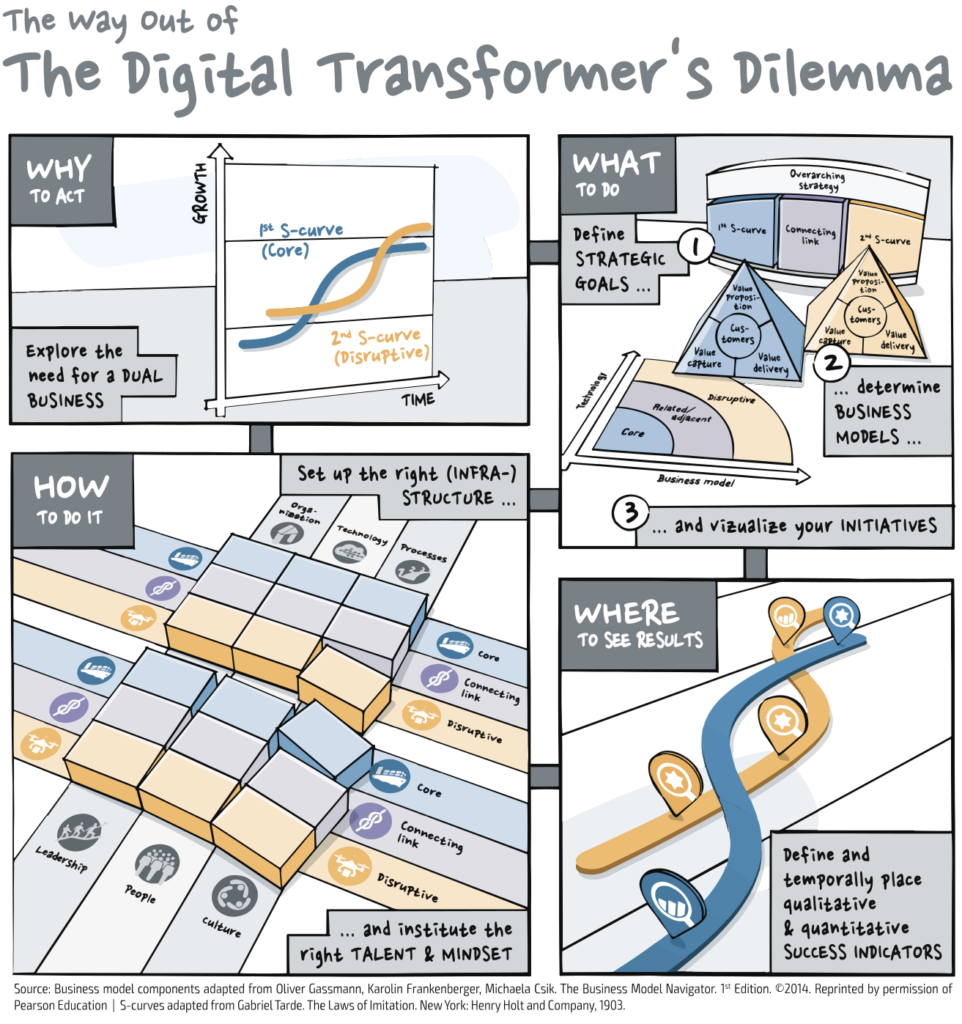The Solution
To best illustrate how to run a successful digital transformation, practitioners ought to follow steps along 4 digital transformation elements. For each step, we highlight how to strike a balance in efforts across both S-curves
For each of the elements of our framework – Why, What, How, Where – there is also a tool to use, not just stare at. The tools help you assess the status quo, map out your options and prioritize next steps, following best practices from the book.
Click on the framework elements to learn more.

WHY to act
- We investigate reasons for embarking on a digital transformation to begin with and explain why a dual business that allows exploiting traditional business activities (1st S-curve) and exploring ways of reaping the full digital potential (2nd S-curve) is necessary. We also look at why so many companies have failed to act timely and get it right.
- The Why tool juxtaposes your reasons to optimize your core business with the potential for radically new, disruptive business ideas. Gather your thoughts on post-its to determine 1st and 2nd S-curve digital transformation drivers and thus determine your reasons to act.
WHAT to do
- We describe how to develop an overarching strategy that includes a strategy for the core business, a strategy for the new, disruptive (digital) business and a plan for how to marry the two and adequately manage the interactions between the two. We also provide advice on how to develop a business model rooted in novel ways of value creation and value capture to bring the strategy to life, and guide practitioners on how to go from strategy to business model.
- The What tool consists of three sub-parts First, it invites you to jot down your overarching strategy, the 1st S-curve strategy, your 2nd S-curve strategy as well as connecting elements between the two. Second, it helps you organize your thoughts around your business models. Post-its in each of the four sections of the business model triangle map out your 1st and 2nd S-curve business models; connecting elements are those that both S-curves have in common and can thus be leveraged further. Third, it guides you in the visualization of your efforts as they relate to business models and technologies, helping you to prioritize them as well.
HOW to do it
- The real challenge lies in the nuts and bolts of getting the transformation done – and this is what this book focuses on. To make sure the implementation goes smoothly, we explain how to set up the right (infra-) structure (organization, technology, processes) and institute the right talent and mindset (leadership, people, culture).
- For the 6 How dimensions, the tool lays out your 1st S-curve efforts, 2nd S-curve efforts and the link between the two. This tool can be used to assess the status quo or to define an ambition level. Whether you use it as a backward-looking tool to assess what has already happened or a forward-looking tool to determine concrete next steps is up to you and will depend on the setting. We recommend doing both.
WHERE to see results
- Let’s not forget that also in a digital transformation does the age-old saying hold: only what gets measured gets done. Measuring impact is therefore quintessential. We illustrate how to go about measurement across and specific to both S-curves, balancing qualitative and quantitative KPIs. We also make sure to mention how to set objectives, assign accountability and ensure transparency vis-à-vis the relevant stakeholder group.
- The Where tool helps you define KPIs for your two S-curves. Make sure to opt for a healthy mix of qualitative and quantitative KPIs suited to the respective S-curve (the first section of the tool) and then place those post-its along the S-curves according to when you would use them. You can do this exercise on a macro level (take stock of your holistic digital transformation KPIs on a company level) or micro level (assess the KPIs for individual strategic initiatives). We recommend doing both.
